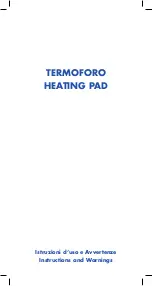
1
INSTRUCTIONS
67589 01/16 (LOA)
English
The thermostat is an electronic on/off thermo-
stat for temperature control of electric under-
floor heating by means of an NTC sensor.
The thermostat has a built-in two-pole ground
fault circuit interrupter (GFCI, Class A). The
thermostat and GFCI are suitable for 120-240 V
(incl. 208 V) 50/60 Hz power supplies.
The thermostat is for flush mounts in a wall
socket.
Product programme
FLK30-120/240GA (UTN-4991)
Non-programmable thermostat incl. floor sensor
Warning
To avoid electric shock, disconnect
the heating system power supply
at the main panel before installation
and maintenance of the thermostat.
Keep thermostat air vents clean and free from
obstruction. This thermostat is an electrical
device and must be installed in compliance with
national and/or local electrical codes. Instal-
lation must be performed by qualified personnel
where required by law.
The thermostat is designed for resistive load
only. The resistive load must not exceed 15 A
(1800 W at 120 Vac / 3120 W at 208 Vac / 3600
W at 240 Vac).
Warning
Do not loosen the terminal screws
further than the mechanical stop.
Otherwise this will damage the termi-
nal (fig. 2).
Mounting of thermostat
Temperature sensor
1.
Use a screwdriver to release the catch and
remove the front cover (fig. 1).
2.
Connect the floor sensor to the terminals
marked “sensor”, terminals C and D (fig. 5).
3.
Mount the thermostat in the wall socket.
4.
Carefully replace the front cover by first
positioning its upper edge and then clicking
it into place.
Line cable
Delivers power from the service panel (breaker
panel or fuse box) to the thermostat.
This cable must only be connected to the ther-
mostat’s line terminals, marked L1 and L2.
1.
Connect power cable to terminals 2 and 3
on the back of the thermostat (fig. 2).
Load cable
Delivers power from the thermostat to the heat-
ing cable.
This cable must only be connected to the ther-
mostat’s load terminals, marked load 15 A.
1.
Connect heating cable to terminals 1 and 4
on the back of the thermostat (fig. 2).
2.
The detachable cover on the back of the
thermostat (fig. 1) is designed to prevent
uninsulated ground wires from dropping
onto the terminals after installation has been
completed.
Mounting of floor sensor (fig. 3)
Floor sensor is supplied from SELV (Safety
Extra low Voltage) Circuit, allowing the sensor
to be placed as close to the floor surface as
desired without having to take special account
to the risk of shock at the damage to the sensor
cable. It is not intended that the temperature
sensor wire shall enter through the wall socket
mounting box. The sensor cable shall be sep-
erated from LINE and LOAD cables. Can be
separated in conduite, inside or outside the
wall. (see fig. 6)
Recommended placed in an non conductive
installation pipe, which is embedded in the
floor. (fig. 3). The pipe must be sealed in the end
and placed as high as possible in the concrete
layer. The sensor cable shall be placed in a sep-
arate pipe or be separated from power cables.
The floor sensor must be centered in between
the heating cable.
The sensor cable can be extended up to 90 ft
(30 m) by means of a separate two-core cable.
Two remaining cores of a multi-core cable
which, for example, supplies current to the floor
heating wires, must not be used. The two-core
cable must be placed in a separate pipe or be
separated from power cables.
Other approved floor sensors may be used if
they comply with the technical specifications
(see fig. 4).
Operation
The actual temperature setting is shown and the
thermostat is ready for use.
Checking the GFCI
It is important that the GFCI is checked for cor-
rect installation and function upon installation
and monthly thereafter.
To check the GFCI:
Press the “TEST” button.
The test is successful if the red LED on the
right of the thermostat flashes once every two
seconds and “GROUND FAULT” appears on
the display. If this does not occur, check the
installation.
Press the “Standby/Reset” button to reset the
GFCI.
The red LED will stop flashing and the display
returns to its normal appearance.
If the test fails, repeat the test. If it continues to
fail, ask an electrician to check the installation.
If, during normal operation, the GFCI/ trips
without the “TEST” button being pressed, there
could be a ground fault! To check whether it
is a ground fault or nuisance tripping, press
“Standby/Reset”. If this causes the red LED to
stop flashing and stay off, it was nuisance trip-
ping and the system is operating correctly. If
this does not occur, there is a ground fault! In
case of a ground fault, it is important to have
the installation checked by a qualified electri-
cian according to local and national regulations.
The red LED on the right of the thermostat can
indicate four different GFCI states:
1. LED off – NORMAL state.
2. LED flashing slowly (once every two sec-
onds) – TRIGGERED state. Try pressing the
“Standby/Reset” button to reset the GFCI.
3. LED flashing quickly (five flashes per sec-
ond) – ERROR state. Try switching the pow-
er off and then back on again. If the thermo-
stat re-enters the ERROR state, either the
wiring is wrong (a GN exists) or the unit is
defective and must be replaced.
4. LED lit constantly – Internal microprocessor
malfunction or abnormal fault in hardware!
Try switching the thermostat off and then
back on again. If the LED is still constantly
lit, the GFCI is defective and the thermostat
must be replaced.
Note: The LED lights up briefly without flashing
during every power-up.
Fault location
If the sensor is disconnected or short-circuited,
the heating system is switched off. The sensor
can be checked against the resistance table
(fig. 4).
Error codes
E0: Internal error. The thermostat must be
replaced.
E2: External sensor short-circuited or discon-
nected.
UL Listed for the US and Canada
According to the following standards:
Thermostat:
UL 60730-1
UL 60730-2-9
CSA E60730-1:13
CSA E60730-2-9
UL file number: E157297
GFCI:
UL 943 4th ed.
CSA C22.2 No. 144.1-06
Classification
The product is a class II device (reinforced insu-
lation) and must be connected to the following
leads:
Phase L1 (L)
120V
Neutral L2 (N) 0/120 V
Max. load 15 A (resistive load).
The thermostat is intended to be used with
underfloor heating.
The terminals are suitable for field wiring cables
of 12 to 22 AWG.
Technical data
Supply ........................... 120/240 Vac 50/60 Hz
Load
.......................max. 15 A (resistive load)
Power ................................1.800 W at 120 Vac
................................3.120 W at 208 Vac
................................3.600 W at 240 Vac
GFCI ......................... Class A (5 mA trip level)
Temperature range ........................ +5 to +40°C,
+41 to +104°F
Français
Le thermostat est un thermostat électronique
marche/arrêt pour le contrôle de la température
d’un plancher chauffant par une sonde NTC.
Le thermostat possède un disjoncteur diffé-
rentiel de fuite à la terre intégré à deux pôles
(DDFT, classe A). Le thermostat et le disjoncteur
de fuite à la terre intégré sont conçus pour des
alimentations à 120-240 V (y compris 208 V) et
50/60 Hz.
Le thermostat est conçu pour un montage
affleurant dans un boîtier mural.
Type FLK30
© 2016 OJ Electronics A/S
Содержание FLK30
Страница 5: ...5 2016 OJ Electronics A S...
Страница 6: ...6 2016 OJ Electronics A S...
Страница 7: ...7 2016 OJ Electronics A S...


























